Preliminary Studies on Rare Elements Addition and Effect on Oxidation Behaviour of Pack Cementation Coatings Deposited on Variety of Steels at High Temperature
Abstract
:1. Introduction
2. Experimental Procedure
2.1. Materials
2.2. Pack Cementation Process
2.3. Air Oxidation
3. Results and Discussion
3.1. As-Deposited Diffusion Coatings
3.2. Mass Gain Data
3.3. XRD Analyses
3.4. Macro Observations
3.5. SEM X-ray Mapping Analyses
4. Conclusions
- A high degree of protection was found when the coating was deposited on 16M, T91, and VM12 steel.
- There was not much difference in terms of protection when the coating was doped with RE addition, but pack coatings secure the scale spallation in 16M steel.
- Not much effect was observed in high Cr steels SANICRO25 and Super 304H with pack coatings with and without the addition of Gd, La, and CeO2.
- EDS X-ray mapping of the coated SANICRO25 steel showed that Gd has no effect on pack cementation coating. However, La and CeO2 addition indicated a thinning of the coating.
- Voids were observed in the outermost region of the coating due to the Kirkendall effect and internal stress formation.
- The number of voids was much lower than in the coating with no addition and with the addition of Gd.
Author Contributions
Funding
Institutional Review Board Statement
Informed Consent Statement
Data Availability Statement
Conflicts of Interest
References
- Mevrel, R.; Duret, C.; Pichoir, R. Pack cementation processes. Mater. Sci. Technol. 1986, 2, 201–206. [Google Scholar] [CrossRef]
- Xiang, Z.D.; Datta, P.K. Relationship between pack chemistry and aluminide coating formation for low-temperature aluminisation of alloy steels. Acta Mater. 2006, 54, 4453–4463. [Google Scholar] [CrossRef]
- Tejero-Martin, D.; Rad, M.R.; McDonald, A.; Hussain, T. Beyond Traditional Coatings: A Review on Thermal-Sprayed Functional and Smart Coatings. J. Therm. Spray Technol. 2019, 28, 598–644. [Google Scholar] [CrossRef] [Green Version]
- Wang, C.-S. Influence of yttrium on microstructure and properties of Ni–Al alloy coatings prepared by laser cladding. Def. Technol. 2014, 10, 22–27. [Google Scholar] [CrossRef] [Green Version]
- Thakare, J.G.; Pandey, C.; Mahapatra, M.M.; Mulik, R.S. Thermal Barrier Coatings—A State of the Art Review. Met. Mater. Int. 2020, 27, 1–22. [Google Scholar] [CrossRef]
- Guo, L.; Zhang, C.; Li, M.; Sun, W.; Zhang, Z.; Ye, F. Hot corrosion evaluation of Gd2O3-Yb2O3 co-doped Y2O3 stabilized ZrO2 thermal barrier oxides exposed to Na2SO4+V2O5 molten salt. Ceram. Int. 2017, 43, 2780–2785. [Google Scholar] [CrossRef]
- Li, M.X.; He, Y.Z.; Yuan, X.M. Effect of nano-Y2O3 on microstructure of laser cladding cobalt-based alloy coatings. Appl. Surf. Sci. 2006, 252, 2882–2887. [Google Scholar]
- Qi, X.; Zhu, S. Effect of CeO2 addition on thermal shock resistance of WC–12%Co coating deposited on ductile iron by electric contact surface strengthening. Appl. Surf. Sci. 2015, 349, 792–797. [Google Scholar] [CrossRef]
- Sharma, S.P.; Dwivedi, D.K.; Jain, P.K. Effect of CeO2 addition on the microstructure, hardness, and abrasive wear behaviour of flame-sprayed Ni-based coatings. Proc. Inst. Mech. Eng. Part J J. Eng. Tribol. 2008, 222, 925–933. [Google Scholar] [CrossRef]
- Zhang, J.; Guo, X.; Jung, Y.-G.; Li, L.; Knapp, J. Lanthanum zirconate based thermal barrier coatings: A review. Surf. Coat. Technol. 2016, 323, 18–29. [Google Scholar] [CrossRef] [Green Version]
- Whittle, D.P.; Stringer, J. Improvements in high temperature oxidation resistance by adding of reactive elements or oxide dispersions. Philos. Trans. R. Soc. 1980, 295, 309–329. [Google Scholar]
- Pint, B.A.; Hobbs, L.W. The formation of α-Al2O3 scales at 1500 °C. Oxid. Met. 1994, 41, 203–233. [Google Scholar] [CrossRef]
- Pint, B.A. Experimental observations in support of the dynamic-segregation theory to explain the reactive-element effect. Oxid. Met. 1996, 45, 1–37. [Google Scholar] [CrossRef]
- Sigler, D.R. Adherence behavior of oxide grown in air and synthetic exhaust gas on Fe-Cr-Al alloys containing strong sulfide-forming elements: Ca, Mg, Y, Ce, La, Ti, and Zr. Oxid. Met. 1993, 40, 555–583. [Google Scholar] [CrossRef]
- Pint, B.A.; Martin, J.R.; Hobbs, L.W. 18O/SIMS characterization of the growth mechanism of doped and undoped α-Al2O3. Oxid. Met. 1993, 39, 167–195. [Google Scholar] [CrossRef]
- Jedlinski, J.; Bernasik, A.; Graham, M.J.; Mitchell, D.F.; Sproule, G.I.; Borchardt, G. A combined approach: Isotopic expo-sure/SIMS analysis/SEM to study the early stages of oxidation of β-NiAl at 1473K. Mater. Corros. 1995, 46, 297–305. [Google Scholar] [CrossRef]
- Ishii, K.; Kohno, M.; Ishikawa, S.; Satoh, S. Effect of rare-earth elements on high-temperature oxidation resistance of Fe–20Cr–5Al alloy foils. Mater. Trans. JIM 1997, 38, 787–792. [Google Scholar] [CrossRef] [Green Version]
- Kipkemoi, J.; Tsipas, D. Rare-earth modified chromium-aluminide coatings applied by pack cementation method on low-alloy steels. J. Mater. Sci. 1996, 31, 6247–6250. [Google Scholar] [CrossRef]
- Rohr, V. Development de Revetements Pour les Aciers D’echangeurs Thermiques et Amelioration de leur Resistance a la Corrosion en Environnement Simulant les Fumees de Combustion de Charbon. Ph.D. Thesis, University of Toulouse, Toulouse, France, 2005. (In English). [Google Scholar]
- Xiang, Z.D.; Burnell-Gray, J.S.; Datta, P.K. Conditions for code position of Aland Cr on Ni base superalloys by pack cementation process. Surf. Eng. 2001, 17, 287–294. [Google Scholar] [CrossRef]
- Bianco, R.; Rapp, R.A. Pack cementation diffusion coatings. In Metallurgical and Ceramic Protective Coatings; Stern, K.H., Ed.; Springer: Dordrecht, The Netherlands, 1996. [Google Scholar]
- Saroja, S.; Parameswaran, P.; Vijayalakshmi, M.; Raghunathan, V. Prediction of microstructural states in Cr-Mo steels using phase evolution diagrams. Acta Metall. Mater. 1995, 43, 2985–3000. [Google Scholar] [CrossRef]
- Ennis, P.; Zielinska-Lipiec, A.; Wachter, O.; Czyrska-Filemonowicz, A. Microstructural stability and creep rupture strength of the martensitic steel P92 for advanced power plant. Acta Mater. 1997, 45, 4901–4907. [Google Scholar] [CrossRef]
- Rohr, V.; Donchev, A.; Schutze, M.; Milewska, A.; Perez-Trujillo, F.J. Diffusion coatings for high temperature corrosion protection of 9–12% Cr steels. Corros. Eng. Sci. Technol. 2005, 40, 226–232. [Google Scholar] [CrossRef]
- Agüero, A.; Muelas, R.; Pastor, A.; Osgerby, S. Long exposure steam oxidation testing and mechanical properties of slurry aluminide coatings for steam turbine components. Surf. Coat. Technol. 2005, 200, 1219–1224. [Google Scholar] [CrossRef]
- Bates, B.; Zhang, Y.; Dryepondt, S.; Pint, B. Creep behavior of pack cementation aluminide coatings on Grade 91 ferritic–martensitic alloy. Surf. Coat. Technol. 2013, 240, 32–39. [Google Scholar] [CrossRef]
- Xiang, Z.; Datta, P. Formation of aluminide coatings on low alloy steels at 650 °C by pack cementation process. Mater. Sci. Technol. 2004, 20, 1297–1302. [Google Scholar] [CrossRef]
- Windmann, M.; Röttger, A.; Hahn, I.; Theisen, W. Mechanical properties of AlXFeY intermetallics in Al-base coatings on steel 22MnB5 and resulting wear mechanisms at press-hardening tool steel. Surfaces Surf. Coat. Technol. 2017, 321, 321–327. [Google Scholar] [CrossRef]
- Vegard, L. Die Konstitution der Mischkristalle und die Raumfüllung der Atome. Eur. Phys. J. A 1921, 5, 17–26. [Google Scholar] [CrossRef]
- Xiang, Z.D.; Rose, S.R.; Datta, P.K. Long-term oxidation kinetics of aluminide coatings on alloy steels by low temperature pack cementation process. J. Mater. Sci. 2006, 41, 7353–7360. [Google Scholar] [CrossRef]
- Xiang, Z.D.; Datta, P.K. Low temperature aluminisation of alloy steels by pack cementation process. Mater. Sci. Technol. 2006, 22, 1177–1184. [Google Scholar] [CrossRef]
- Choudhary, R.; Kain, V.; Hubli, R. Formation of alumina-aluminide coatings on ferritic-martensitic T91 steel. J. Min. Metall. Sect. B Metall. 2014, 50, 165–170. [Google Scholar] [CrossRef] [Green Version]
- Sroka, M.; Zielinski, A.; Golański, G.; Puszczalo, T.; Zacłona, J. Influence of Long-Term Impact of Elevated Temperature on the Physical Properties of the Sanicro 25 Steel. Acta Phys. Pol. A 2020, 138, 232–235. [Google Scholar] [CrossRef]
- Gong, Y.F.; De Cooman, B.C. Kirkendall Void Formation during Selective Oxidation. Metall. Mater. Trans. A 2010, 41, 2180–2183. [Google Scholar] [CrossRef] [Green Version]
- Smigelskas, A.D.; Kirkendall, E.O. Zinc Diffusion in Alpha Brass. Trans. AIME 1947, 171, 130–142. [Google Scholar]
- González-Carrasco, J.L.; Guttmann, V.; Fattori, H. Void formation during oxidation of the ODS alloy MA 6000. Metall. Mater. Trans. A 1995, 26, 915–924. [Google Scholar] [CrossRef]
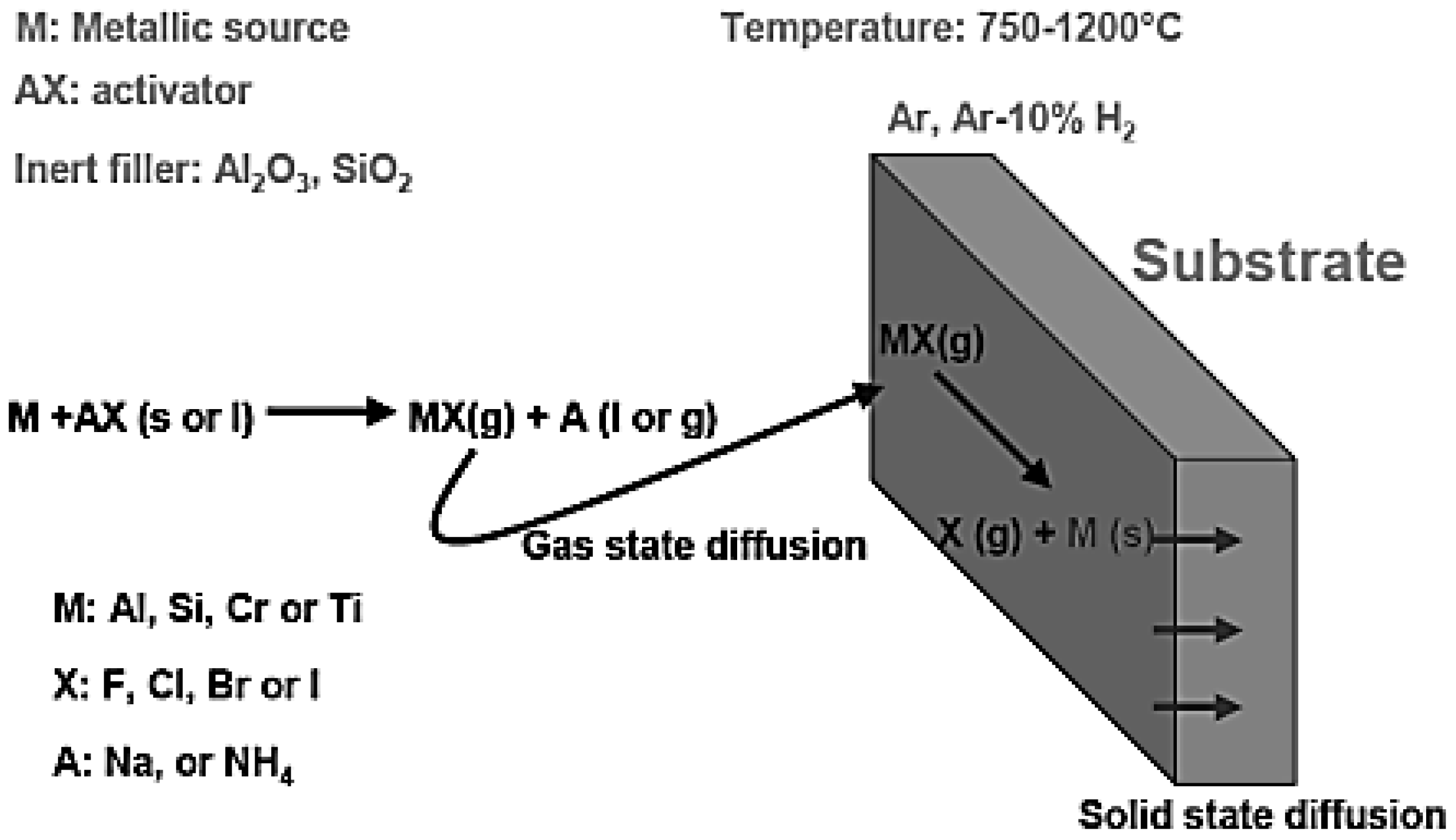


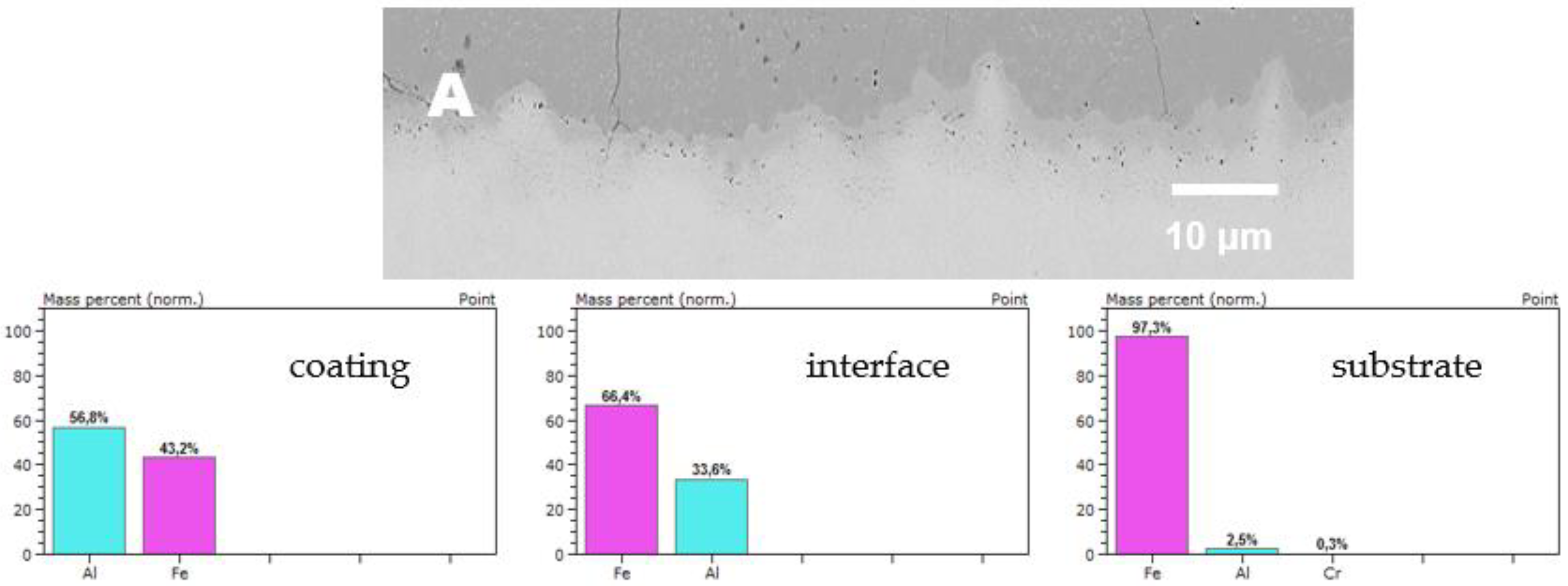
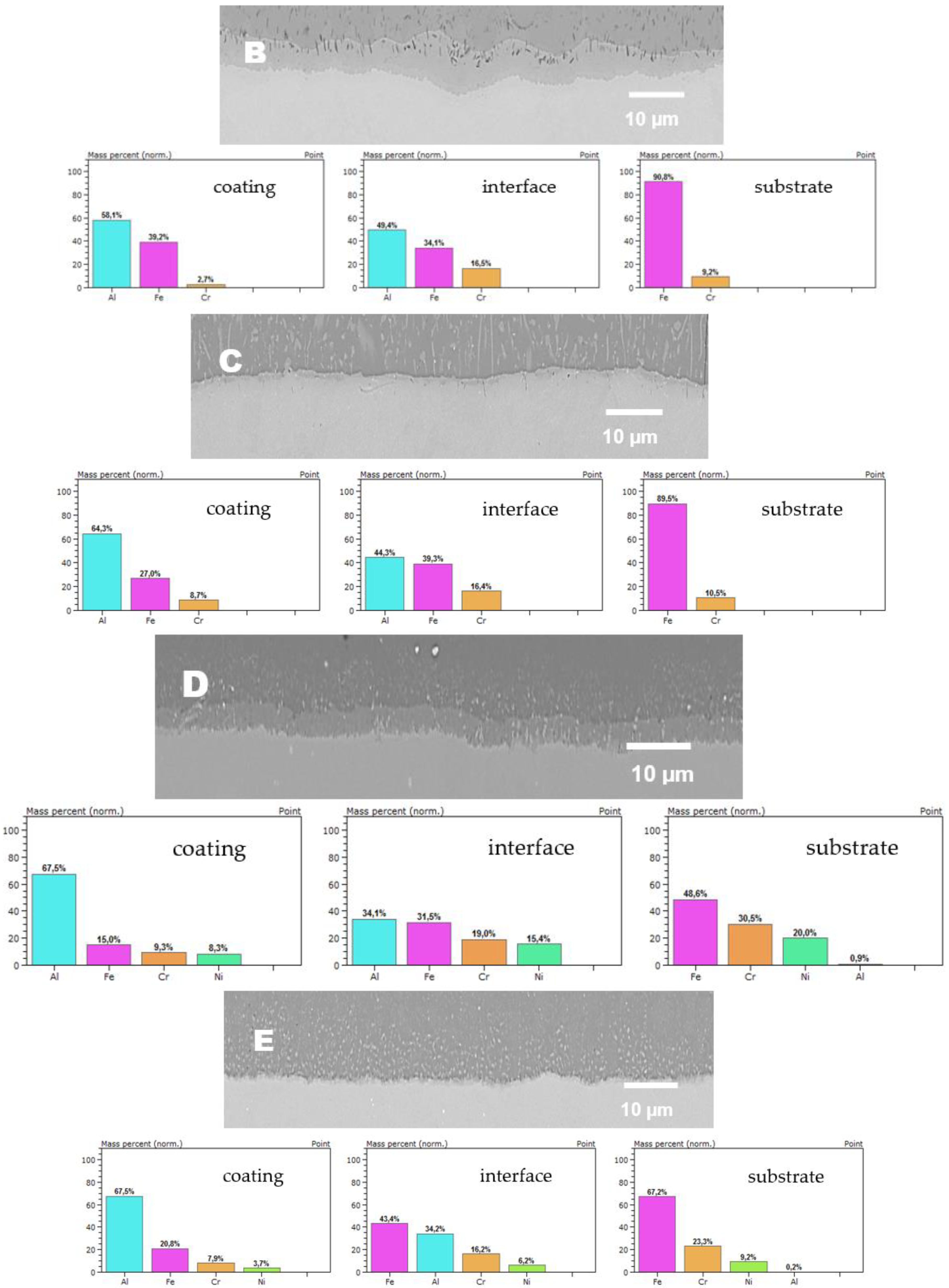
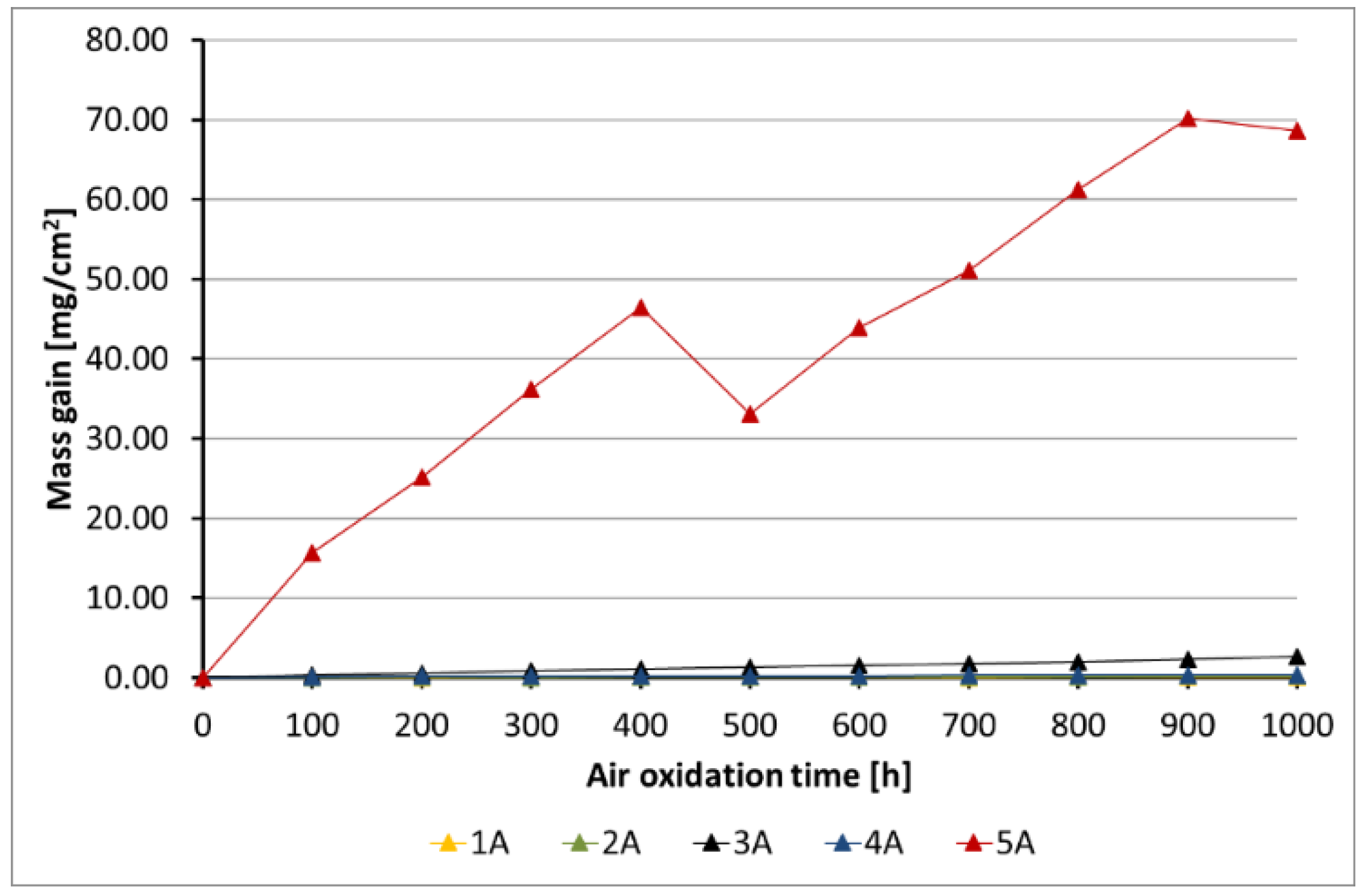
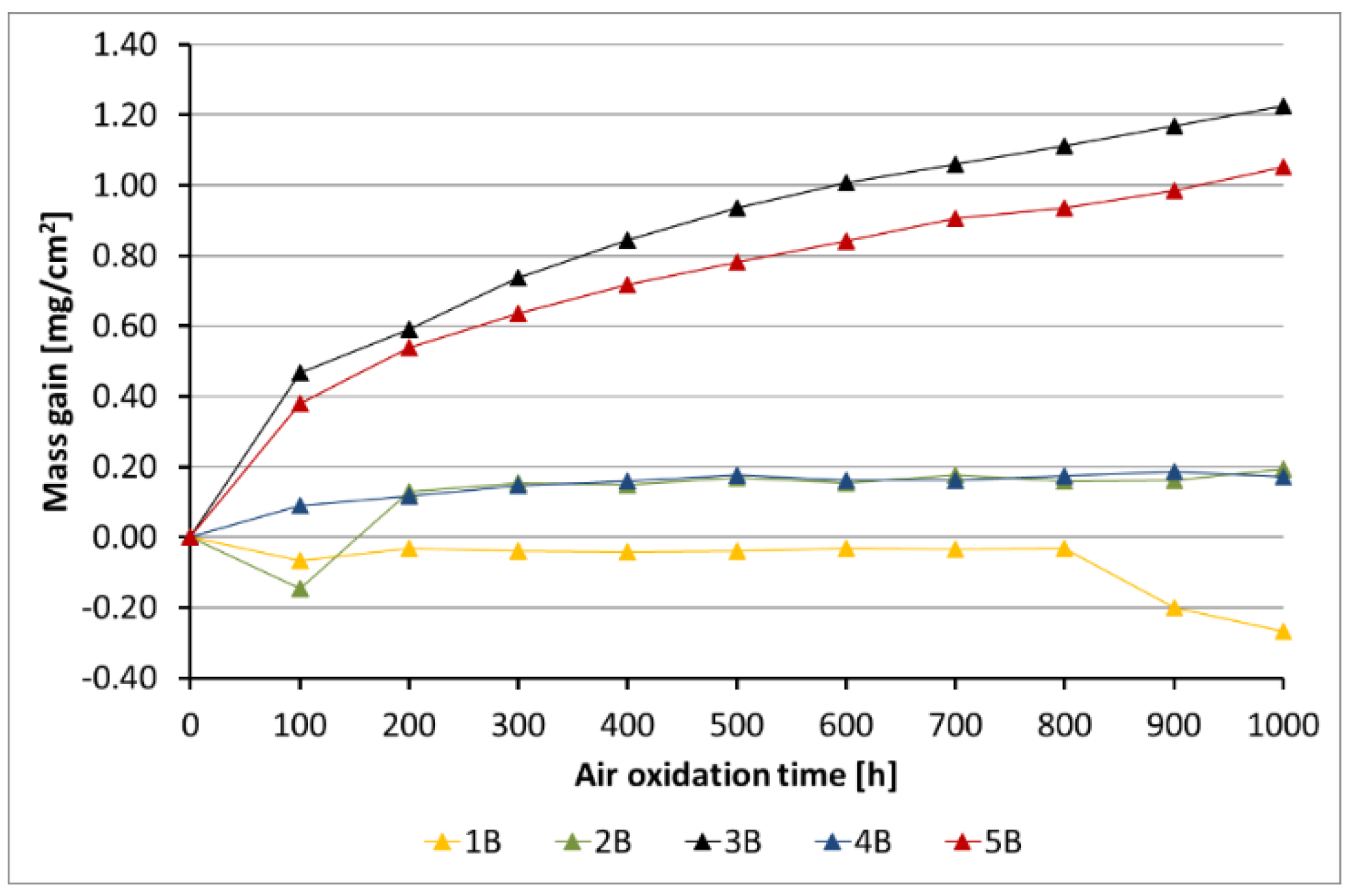
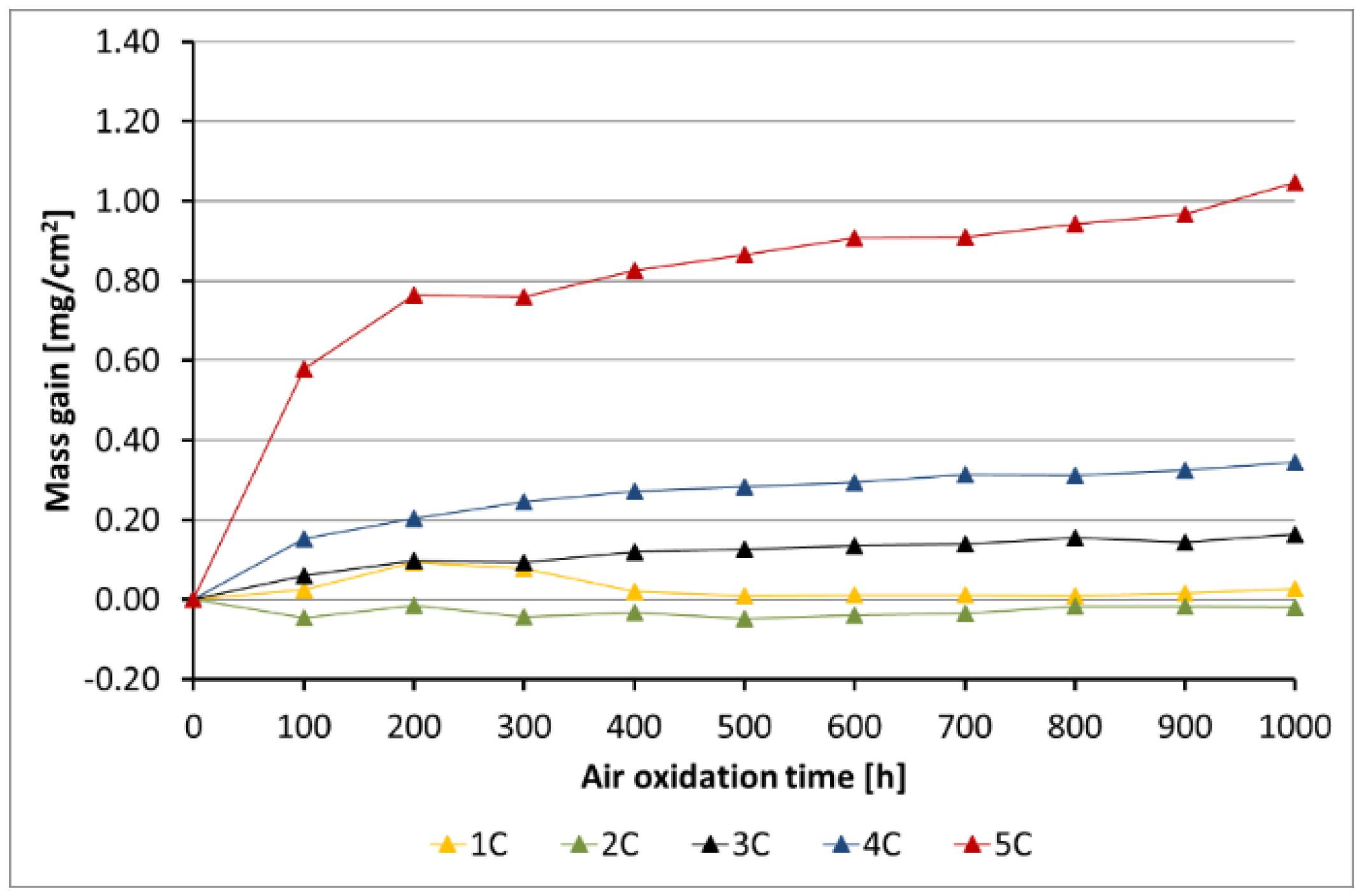
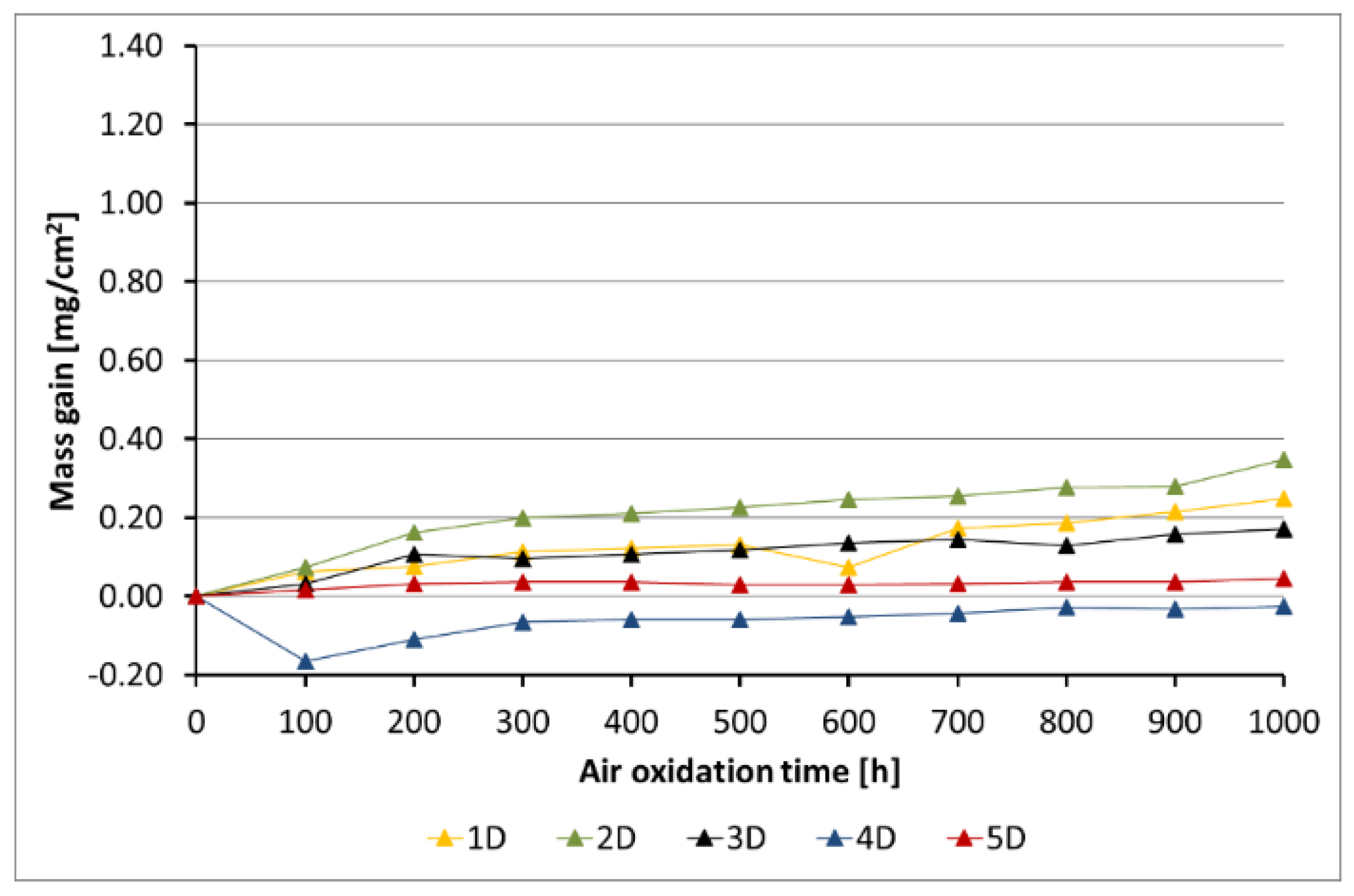



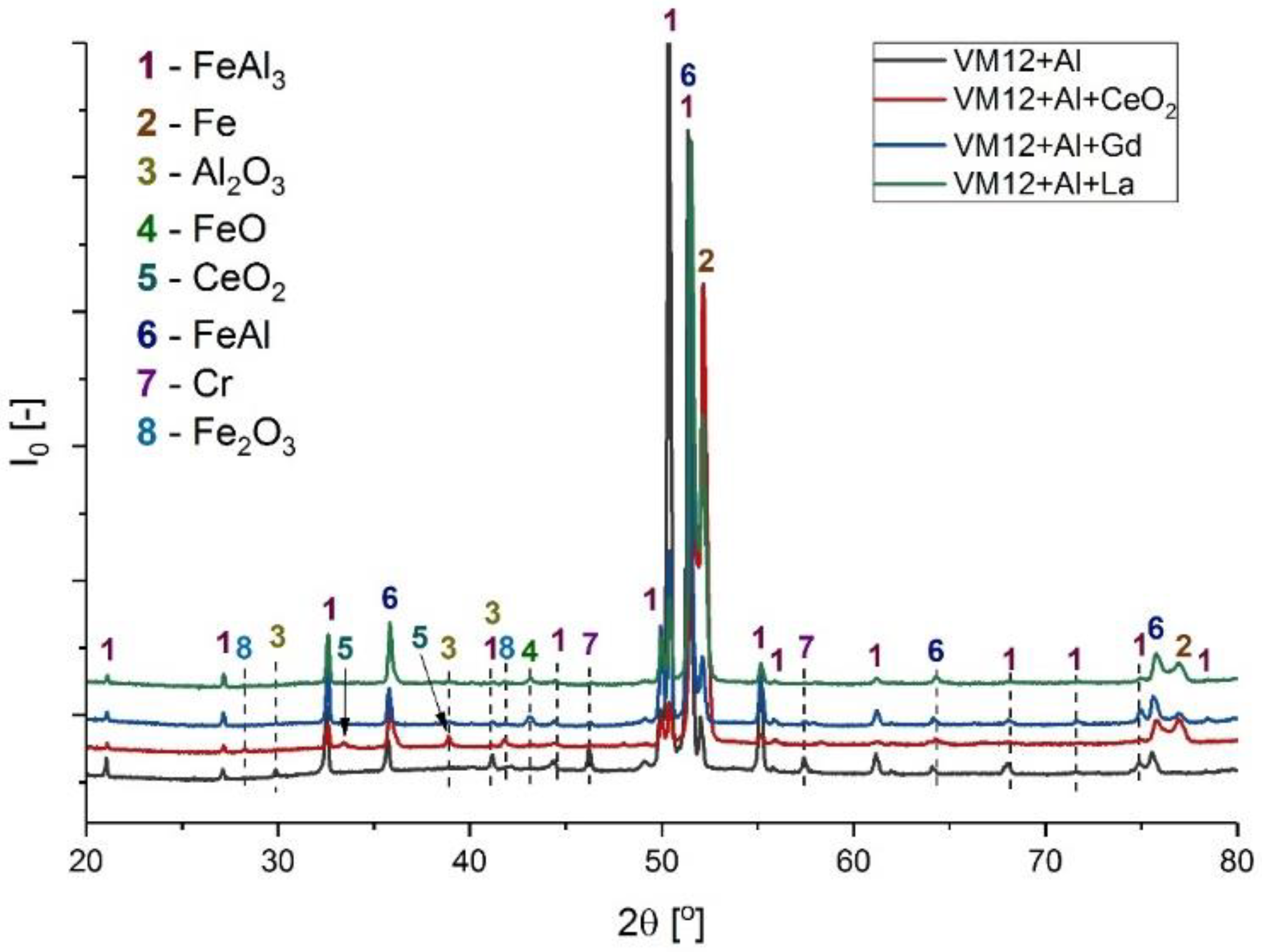

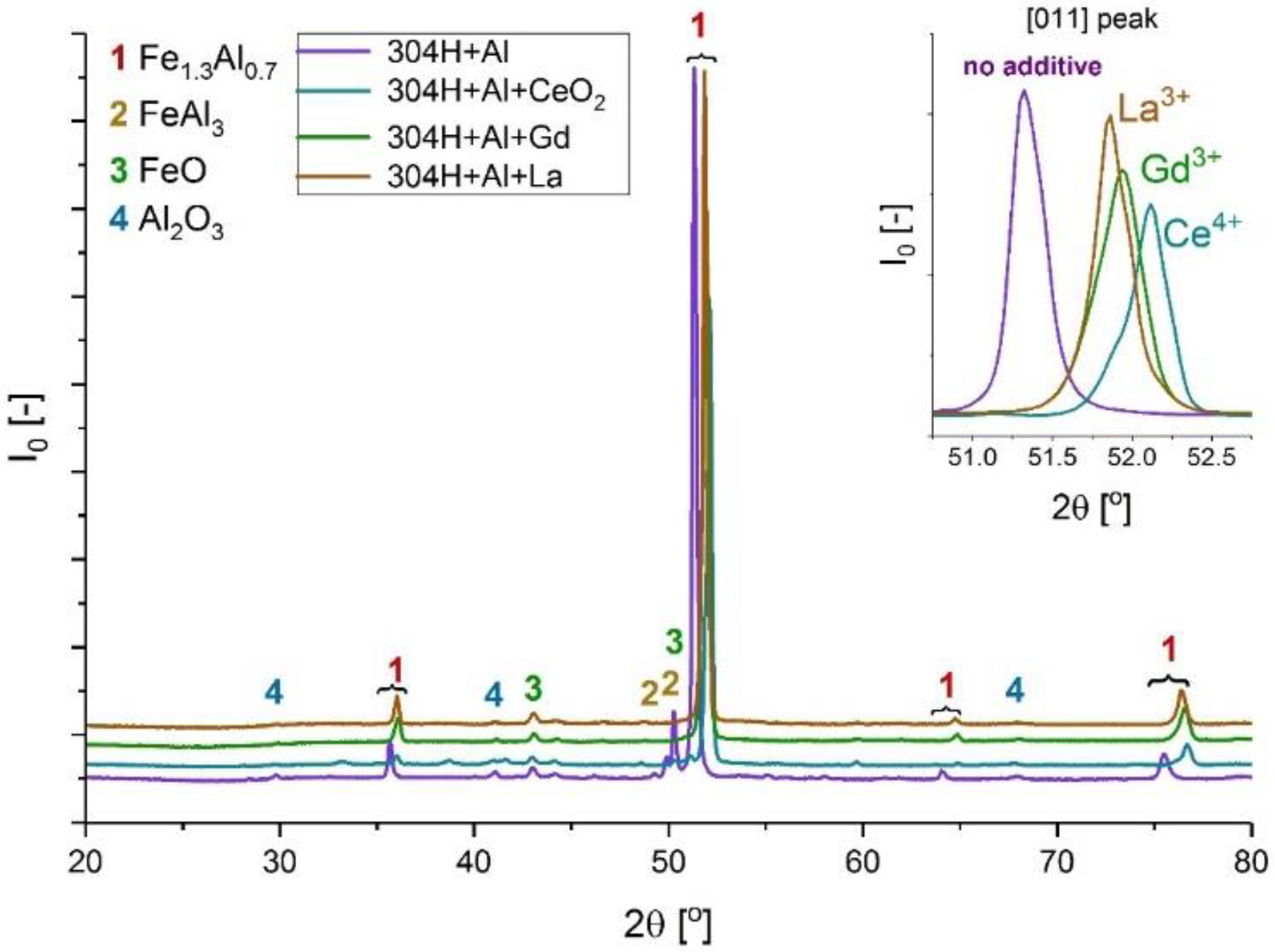
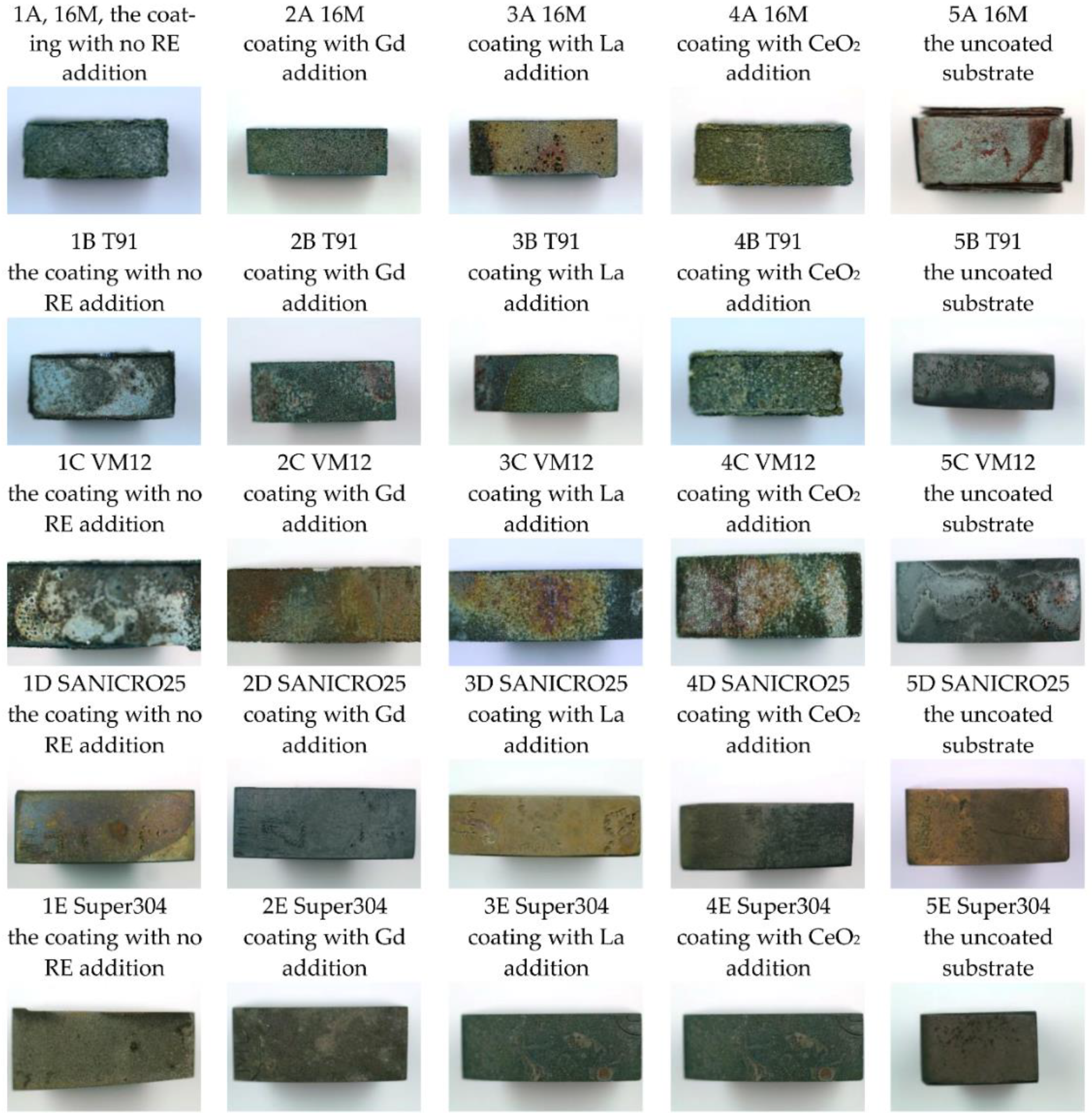
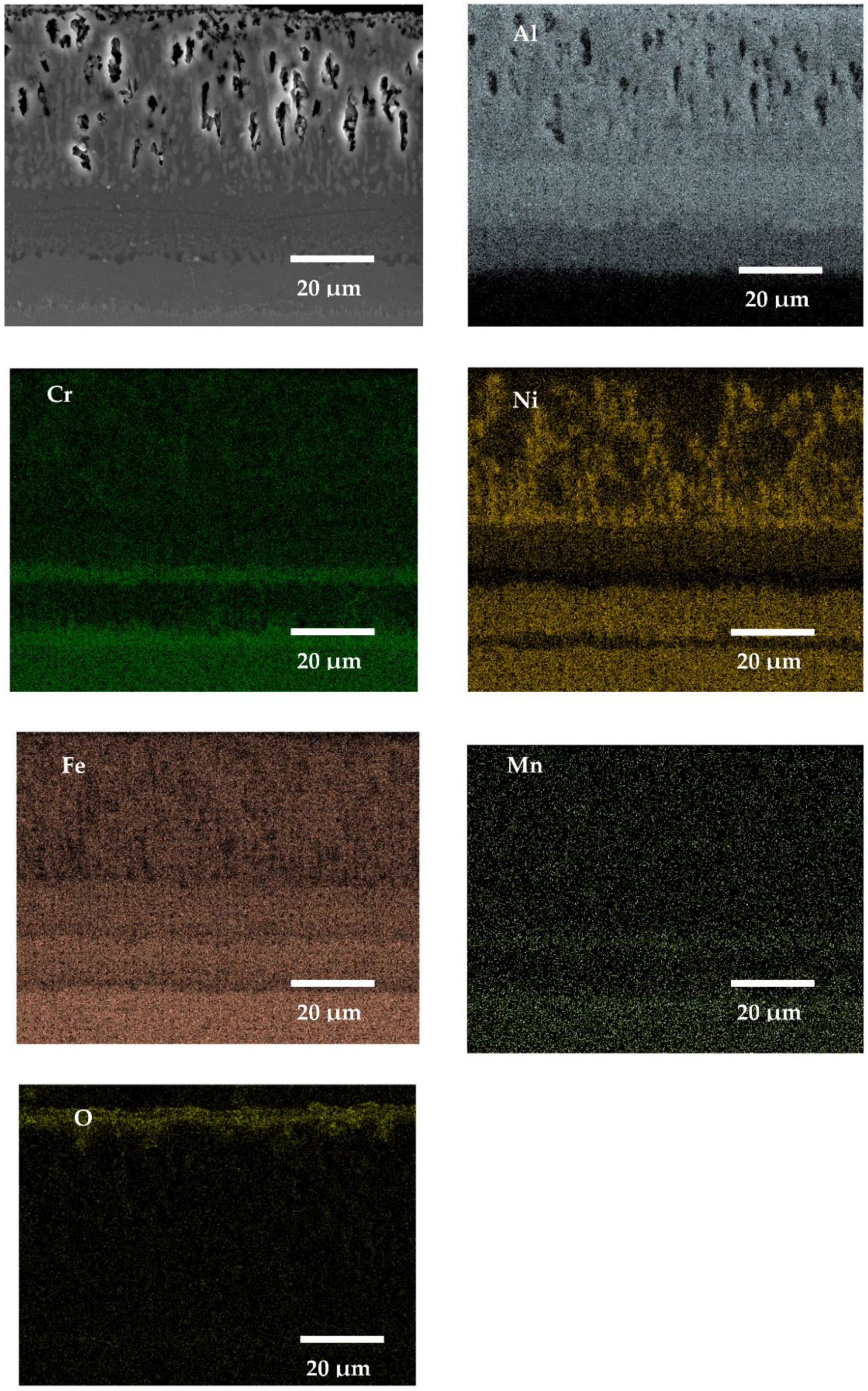
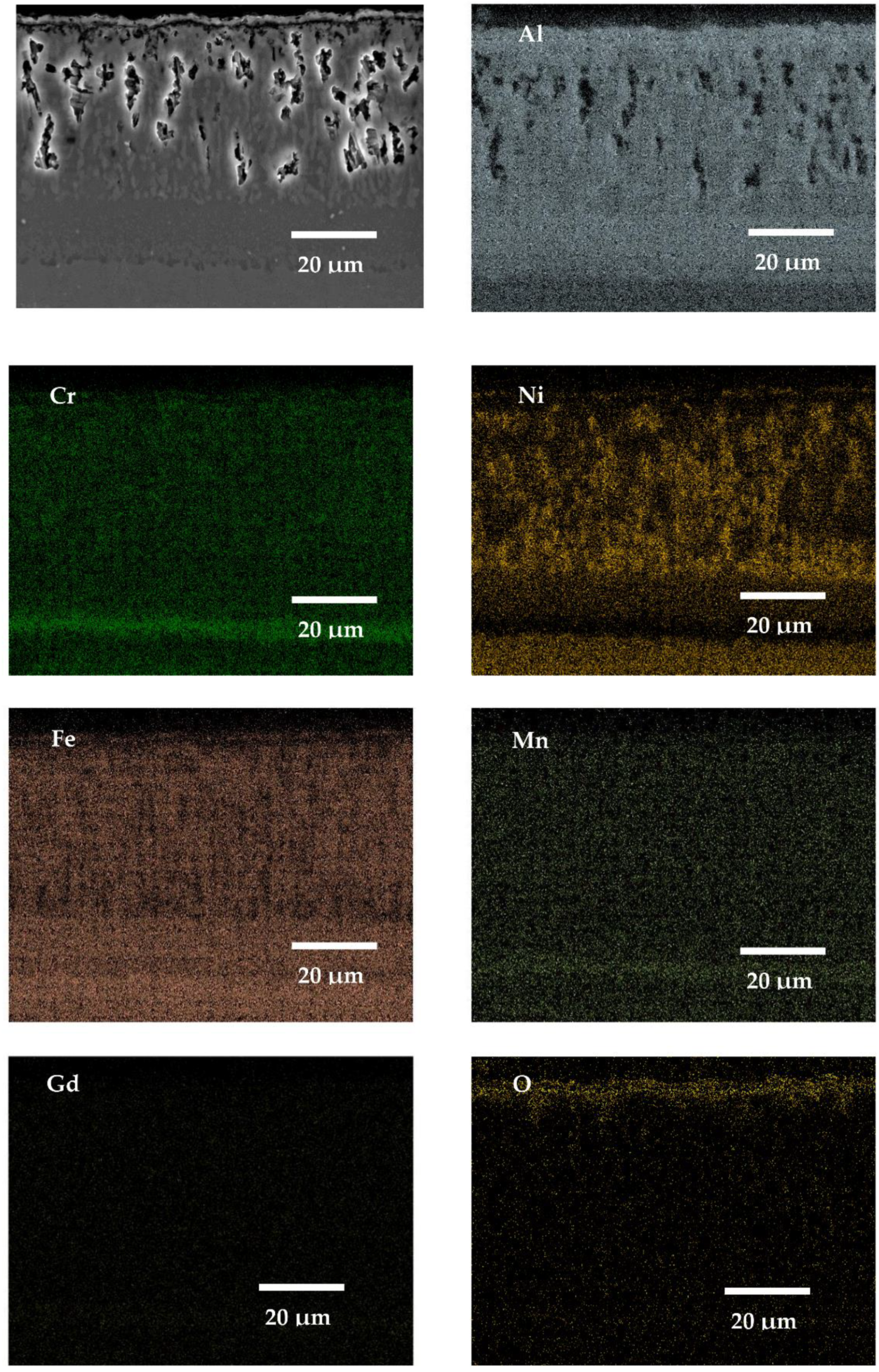
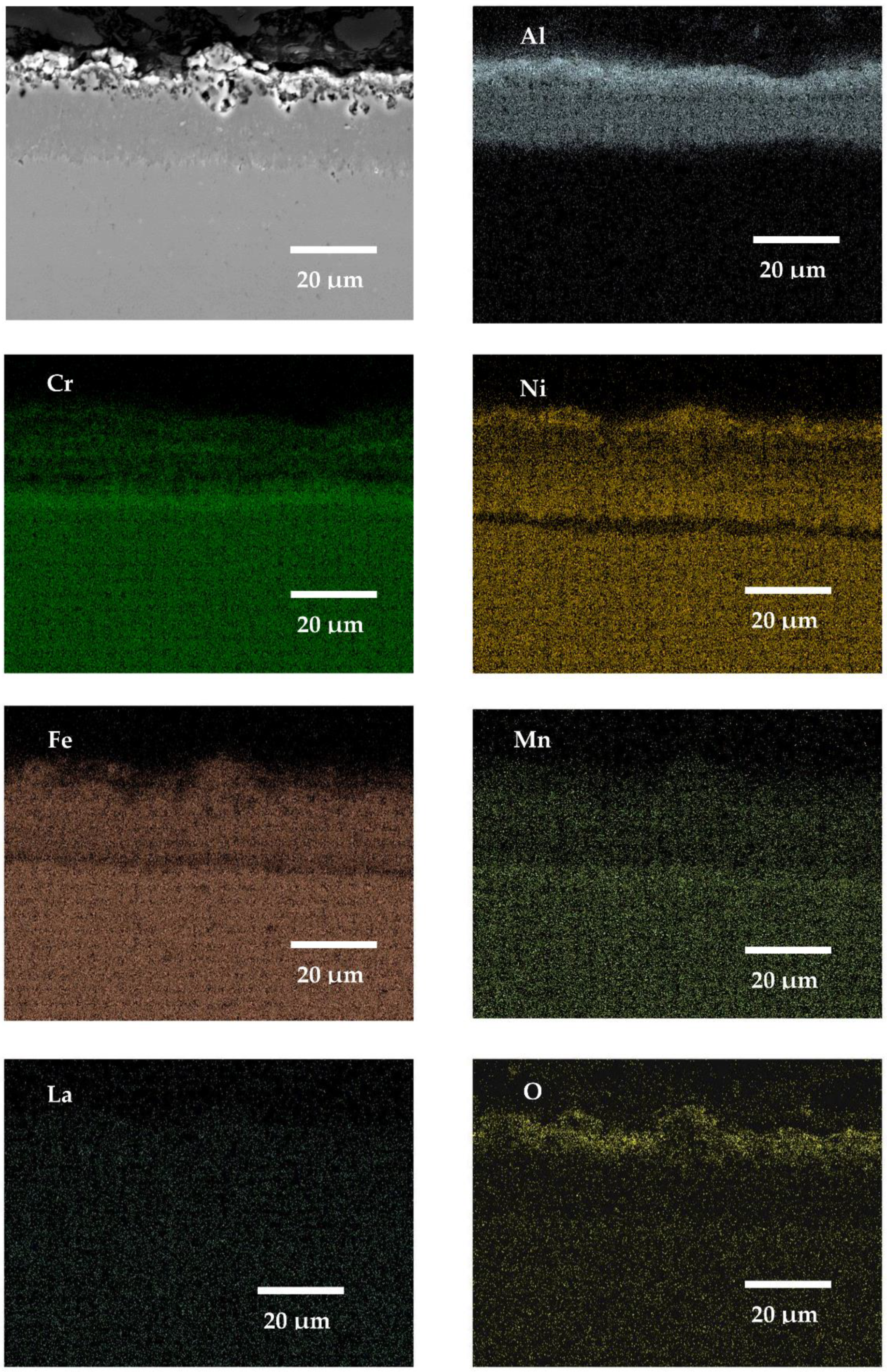

| Steel | C | Si | Mn | P | S | Ni | Cr | Nb | Others: |
|---|---|---|---|---|---|---|---|---|---|
| 16M | 0.12 | <0.35 | 0.4 | 0.025 | 0.025 | - | 0.3 | - | Mo: 0.3 |
| T91 | 0.12 | 0.3 | 0.5 | 0.02 | <0.01 | - | 9.0 | - | Mo: 1 |
| VM12 | 0.12 | 0.5 | 0.5 | - | - | 0.4 | 11.0 | 0.06 | W: 1.5 B: 0.001 N: 0.02 V: 0.2 Mo: 0.4 |
| Super 304H | 0.07 | 0.23 | 0.8 | 0.010 | 0.009 | 8.7 | 18.8 | 0.27 | Cu: 2.68 |
| SANICRO25 | <0.1 | 0.2 | 0.5 | <0.025 | <0.025 | 25.0 | 25.0 | 0.5 | Co: 1.5 W: 3.6 N: 0.23 Cu: 3.0 |
| No. | Code | Steel Grade | Coating Symbol |
|---|---|---|---|
| 1 | A | 16M | 1 (Coating with no RE addition) |
| 2 | 2 (Coating with Gd) | ||
| 3 | 3 (Coating with La) | ||
| 4 | 4 (Coating with CeO2) | ||
| 5 | 5 (Reference sample) | ||
| 6 | B | T91 | 1 (Coating with no RE addition) |
| 7 | 2 (Coating with Gd) | ||
| 8 | 3 (Coating with La) | ||
| 9 | 4 (Coating with CeO2) | ||
| 10 | 5 (Reference sample) | ||
| 11 | C | VM12 | 1 (Coating with no RE addition) |
| 12 | 2 (Coating with Gd) | ||
| 13 | 3 (Coating with La) | ||
| 14 | 4 (Coating with CeO2) | ||
| 15 | 5 (Reference sample) | ||
| 16 | D | SANICRO 25 | 1 (Coating with no RE addition) |
| 17 | 2 (Coating with Gd) | ||
| 18 | 3 (Coating with La) | ||
| 19 | 4 (Coating with CeO2) | ||
| 20 | 5 (Reference sample) | ||
| 21 | E | Super 304H | 1 (Coating with no RE addition) |
| 22 | 2 (Coating with Gd) | ||
| 23 | 3 (Coating with La) | ||
| 24 | 4 Coating with CeO2) | ||
| 25 | 5 (Reference sample) |
Publisher’s Note: MDPI stays neutral with regard to jurisdictional claims in published maps and institutional affiliations. |
© 2021 by the authors. Licensee MDPI, Basel, Switzerland. This article is an open access article distributed under the terms and conditions of the Creative Commons Attribution (CC BY) license (https://creativecommons.org/licenses/by/4.0/).
Share and Cite
Dudziak, T.; Rząd, E.; Polczyk, T.; Jahns, K.; Polkowski, W.; Polkowska, A.; Wójcicki, M. Preliminary Studies on Rare Elements Addition and Effect on Oxidation Behaviour of Pack Cementation Coatings Deposited on Variety of Steels at High Temperature. Materials 2021, 14, 6801. https://doi.org/10.3390/ma14226801
Dudziak T, Rząd E, Polczyk T, Jahns K, Polkowski W, Polkowska A, Wójcicki M. Preliminary Studies on Rare Elements Addition and Effect on Oxidation Behaviour of Pack Cementation Coatings Deposited on Variety of Steels at High Temperature. Materials. 2021; 14(22):6801. https://doi.org/10.3390/ma14226801
Chicago/Turabian StyleDudziak, Tomasz, Ewa Rząd, Tomasz Polczyk, Katrin Jahns, Wojciech Polkowski, Adelajda Polkowska, and Michal Wójcicki. 2021. "Preliminary Studies on Rare Elements Addition and Effect on Oxidation Behaviour of Pack Cementation Coatings Deposited on Variety of Steels at High Temperature" Materials 14, no. 22: 6801. https://doi.org/10.3390/ma14226801






